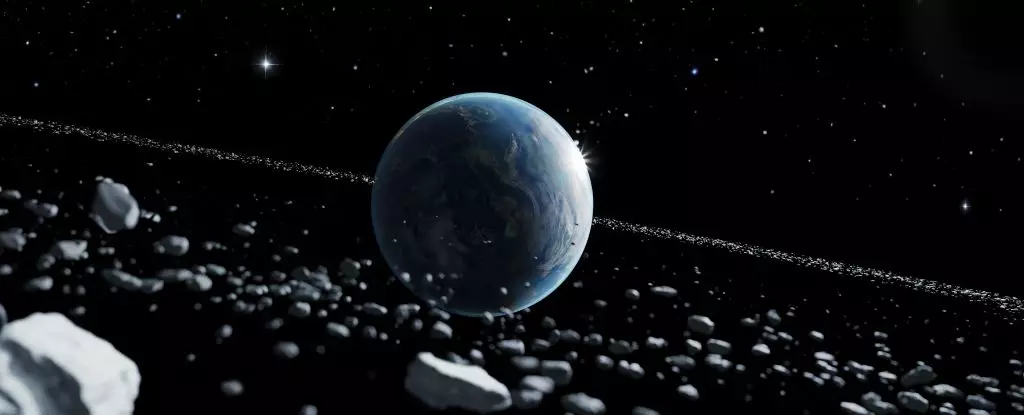In a captivating scenario, our planet might have once been adorned with a splendid ring, much like those seen around Saturn. This intriguing hypothesis proposes that Earth was encircled by a temporary ring composed of debris from an asteroid that met with our planet in a tumultuous encounter tens of millions of years ago. Elaborated upon by planetary scientist Andy Tomkins and his team from Monash University, this theory emerges from a reconstruction of a significant geological anomaly known as the Ordovician impact spike. This phenomenon, occurring nearly half a billion years ago, suggests a remarkable blending of astrological events with the geological record.
The Ordovician Impact Spike: A Closer Examination
During the Ordovician period, approximately 466 million years ago, a remarkable increase in meteorite impacts was noted. Researchers observed a striking spike in meteorite activity over about 40 million years, leading Tomkins and his colleagues to consider the possibility that a degrading ring orbiting Earth could account for this phenomenon. The notion that such a ring could have influenced meteorite impacts not only reshapes our comprehension of Earth’s past but also prompts inquiries regarding the dynamics of celestial interaction within our solar system.
Tomkins’ analysis of 21 craters, all positioned within 30 degrees of the equator, adds weight to this hypothesis. The peculiar proximity of these craters raises questions about the nature of the impacts. An initial glance at the geological evidence shows that, during the Ordovician, the continents were amalgamated into the supercontinent Gondwana. Remarkably, the craters were distributed unevenly, predominantly impacting only 30% of the landmass and oddly localized, as if material rained down from a narrow celestial belt enveloping the planet’s equator.
The narrative continues with the suggestion that a significant asteroid narrowly escaped immediate obliteration upon entering Earth’s gravitational field. Instead, gravitational forces influenced by Earth could have shattered the asteroid into a field of debris, initiating a ring-like structure formed around the planet. This phenomenon resonates with observations from other celestial bodies, such as Jupiter and Saturn, both characterized by their temporary but distinct rings formed from cometary debris or other space materials.
The implications of such an event during the Ordovician extend beyond mere geological curiosity. The excess meteorite material found in sediment suggests a connection with the aforementioned asteroid. Tomkins theorizes that the impacts might have catalyzed significant climatic shifts. Indeed, shortly after this event, Earth succumbed to a harsh ice age, thought to be driven by factors including potential shadowing effects from the hypothesized ring. Efforts to explore these correlations may yield invaluable insights into both Earth’s climatic history and the challenges faced by surviving organisms during this tumultuous period.
The journey towards understanding Earth’s past doesn’t end here. Tomkins advocates for numerical modeling to replicate the dynamics of the asteroid breakup and the subsequent formation and evolution of the proposed ring. Such scientific undertakings stand to illuminate various facets of this historical enigma, shedding light on the potential structure of the ring and its climatic ramifications.
The future modeling efforts aim to explore whether the hypothesized ring could have cast significant shadows on Earth’s surface, potentially exacerbating the cooling climatic conditions that defined the end of the Ordovician. If this hypothesis holds ground, the implications extend far beyond geological history; they touch on broader questions of climate influence, biodiversity, and even future planetary terraforming endeavors.
The Intersection of Climate Change and Evolution
The timing of these geological occurrences aligns tantalizingly with the Great Ordovician Biodiversification Event, a period marked by rapid evolution and diversification of life forms. Would a cooling effect caused by a ring potentially drive the swift adaptation and evolution witnessed in organisms during this epoch? This intriguing concept posits that aspects of planetary dynamics could serve as catalysts for biological evolution.
Moreover, while terraforming Mars or Venus seems a future endeavor shrouded in complexity, contemplating a similar cooling strategy by introducing asteroid debris into the orbit of a hotter planet presents an exhilarating thought experiment. The idea of orchestrating planetary climates through asteroid intervention sparks the imagination and reminds us of the ancient and ongoing interplay between celestial movements and life on Earth.
Conclusion: The Fascination of Celestial Narratives
The tantalizing notion that Earth may once have had a ring encourages a thorough and imaginative exploration of our planet’s past, namely through the perspectives lent by scientific inquiry. The intertwining of astrophysical dynamics with geological histories deepens our appreciation of Earth as a constantly evolving entity shaped by both internal and external forces. Although the existence of Earth’s ring remains speculative, the investigation promises to augment our understanding of life, evolution, and the processes that have sculpted our world over millions of years.

